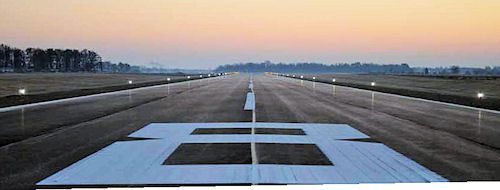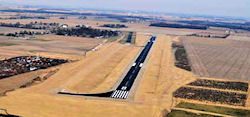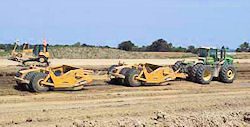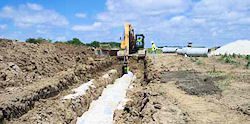
|
Facts & Figures Projects: New Runway Location: Randolph County (IN) Airport Cost: $4,389,190 Size: 4,300 ft. long; 75 ft. wide Funding: 95% FAA; 1.25% state; 3.75% county General Contractor: Milestone Construction Engineer: Butler, Fairman & Seufert Civil Engineers Electrical Contractor: The Hoosier Company Airfield Lighting: ADB Airfield Solutions Seeding Contractor: EarthImages Paving Contractor: Lica Construction Unexpected Twist: An underground natural gas pipeline was discovered during site prep Other Project Elements: LED edge lighting; improved drainage system to reduce runoff; special grass to discourage wildlife |
Built at a cost of nearly $4.4 million, federal funds covered fully 95% of the project. The county and state funded the rest – 3.75% and 1.25%, respectively.
Don Manley, a Butler, Fairman & Seufert engineer who helped design the new runway, considers the various governmental awards an indication of the important role the airport plays in the local economy. Located in the east central part of Indiana just two miles east of Winchester’s central business district, Randolph County Airport is the general aviation hub for the region.
“The FAA has always recognized the role general aviation plays in the business community,” says Manley. “It’s a matter of getting the story out to laypeople who aren’t involved in aviation directly. People don’t see supplies coming to manufacturers. They see products going out on trucks or rail cars. They don’t realize that when something goes down on a machine, it is often complex equipment that requires a special part or a technical expert to be flown in to fix it – and it is general aviation that is called to carry out that important job.”
 Land Acquisition
Land Acquisition
The project actually started more than 10 years ago, when the Randolph County Board of Aviation Commissioners decided the airport needed a new layout and larger runway, explains airport manager Eric Livingston.
The airport’s previous runway was 3,977 feet long and 50 feet wide. The new one is 4,300 feet long and a more standard 75 feet wide.
“The expansion vastly improves the operational characteristics of the airport”, says Manley, noting that it’s now better able to accommodate turbine aircraft passing through the region. Previously, such aircraft had to be lightly loaded to use the airport’s shorter runway. “That meant aircraft leaving Randolph County would likely have to land again later to take on more fuel,” he explains.
In order to expand the runway, the airport needed 21 acres of additional land. Acquiring the tracts, recalls Livingston, proved to be the most volatile aspect of the project.
“People knew who was buying the land, and some wanted $10,000 per acre or didn’t want to sell at all because they didn’t want to see the expansion,” he explains. “There were a handful of people that made for some contentious board meetings. But, we worked through it and everyone was reasonably happy in the end.”
A longer, wider runway will help Randolf County Airport accomodate larger turbo class aircraft.
No Room for Expansion

The airport’s previous configuration confined it to a single runway, and would not have met FAA rules regarding object-free areas for its forecasted traffic. The new runway was designed to accommodate a Hawker 400 turbo class aircraft and other 30,000-pound dual-wheel aircraft. That, in itself, should improve traffic beyond the 250 monthly operations the airport was averaging before construction began, predicts Livingston.
The old runway, which was built in 1938 and paved 20 years later, could not easily be lengthened or widened due to terminal buildings, a nearby housing development and hangars. “Back then, they put it in the best place they thought it should be,” says Livingston. “But, over the years, the community and the airport have grown. We were operating on an FAA waiver due to all the obstructions that had been developed around the facility.”
Another factor tipping the scales in favor of a completely new runway was funding. The FAA would not have “picked up” any costs to renovate the existing runway, notes Livingston.
Forging Ahead
According to Manley, the new runway is designed for a 20-year life supporting an unlimited number of 30,000-pound aircraft. Its alignment, he adds, allows for future expansion to 5,000 feet, which was not previously possible.
In addition to the runway, the project also provided new electrical service to all airport facilities – airside and landside. A new snow removal equipment storage building acquired during a separate project will especially benefit from the new connection.
“We did a lot for the community in a very short period of time,” says Manley.
Milestone Construction was awarded the project in April and broke ground in early May. Despite wet conditions in May and June that delayed most of the work until July, workers completed the runway by the end of October.
“We had an unseasonably dry fall from August on, with no rainfall to speak of, which allowed us to get caught up on the schedule,” explains Wayne Jester, the general contractor from Milestone Construction. “We had to apply some water to keep dust down on the project site and wet grade the land for compaction purposes, but that wasn’t out of the ordinary for a project of this size.”
Crews encountered a previously unknown natural gas pipeline during preliminary site preparations.
Underground Surprise

Once the land was acquired, contractors expected to make quick work of clearing the farmland and removing a few rows of fencing. But shortly after construction began, crews discovered a high-pressure natural gas line running through the property.
“One of the laws of construction is that gas lines find you as soon as you put equipment in place,” jokes Jester. “Fortunately, we started the project in plenty of time and worked with the designer to make sure the clearances and drainage still worked correctly without interfering with the pipeline.”
“The markers were missing, and many people thought it went along the various property lines,” relates Livingston. “It could have been disastrous when we were drilling core samples for the environmental studies.”
 Livingston credits Jason Clearwater, the airport’s engineer who was onsite supervising the project, for helping move the project along.
Livingston credits Jason Clearwater, the airport’s engineer who was onsite supervising the project, for helping move the project along.
“Quick work in the field to locate the line both horizontally and vertically allowed for minor design changes to the storm sewer to occur,” he explains. “No delay to the construction occurred as a result of this unforeseen situation.”
Other than the gas line hiccup, construction was a breeze, says Jester. “Anytime we can build new construction in a cornfield, we get excited. It’s not often we get work like that,” he relates. “Often, we must negotiate around existing utilities and in tight spaces. Getting a chance to lay 4,300 feet of new asphalt in a former cornfield is like going on vacation.”
Airport officials anticipate decreased energy and lamp replacement costs with the runway’s new LED’s.
Neighborhood Issue

To minimize runoff to the nearby residential area, the airport built a drainage system that funnels water into a series of retention systems – but not in amounts that would attract wildlife, qualifies Manley.
“We designed it to retain water for as much as 24 hours as it slowly fed into a county drainage system that employees in another county department maintained,” he explains. “We didn’t want to put a lot of flow in there at once. So, the system holds the water temporarily and releases it at the same amount and rate that occurred before the project.”
The drainage system involved constructing 6,000 feet of storm pipe and feeder ditches from each side into a trunk that leads off site and drains into an existing ditch. The water now collects in an open grassy area between the runway and taxiway system. Even water from heavy rainfall should not flow over the pavement.
“It required a lot of teamwork between the airport staff and contractors, as well as weekly meetings among all parties involved, to make it all happen on time and within budget,” notes Jester. “We were fortunate that decisions could be made rapidly to build everything within the shortened construction timeframe.”
Acquiring land for the new runway proved more challenging than clearing and preparing it for construction.
LED Pioneers

The runway project also included new lighting. Just weeks after the FAA approved use of medium-intensity LED edge lighting, crews installed the new fixtures at Randolph County Airport, making it the first airport in the country to employ the new technology, says Manley.
Jester considers the airport “forward thinking” for pushing ahead with design of the project before FAA approval was in place.
Replacing traditional quartz bulbs, the new lights are more energy efficient and reduce airport utility costs by 30%, reports Manley. Instead of the large 15-kilowatt regulator, the new LED lights require just 7.5 kilowatts to operate.
The lights were installed with an “Arctic Kit” that includes a heater controlled by a thermostat. Because typical LED lighting does not produce much heat, the option is needed to melt snow and ice off the fixtures in the winter, explains Bill Weigel, regional sales manager with ADB Airfield Solutions. The heater draws additional energy when in operation, and the thermostat controls the on/off cycle to maximize energy savings. The heater does not run during summer months and only operates about 50% of the time during winter months – just enough to melt any potential snow and ice buildup, notes Weigel.
“We installed LED lights as often as we could throughout the airport,” Manley explains, noting they are also being used for runway end identification lights, taxiway guidance signs and taxiway edge lights. LEDs even illuminate wind cones and airport identification signage, adds Livingston.
According to Weigel, the lights offer exceptionally clear color output, and the LEDs and associated electronics are rated to a minimum of 100,000 hours of operation, with potential for 150,000 hours.
“Many people understand that LEDs are green energy as far as cost savings go,” he notes. “But many don’t realize the increased green aspect of manufacturing LEDs over traditional incandescent technologies.”
Although LEDs have a higher initial acquisition cost, less frequent lamp replacement provides tremendous long-term cost savings – especially when labor costs are included, says Weigel. He also considers keeping maintenance personnel off runways a “forgotten safety advantage” of LEDs.
Contractors also improved obstruction lighting to help pilots avoid flying near a residential subdivision north of the airport. To power the LED obstruction lights, the project called for installation of solar panels tied to batteries that provide “very good storage life,” says Manley.
The advantage to that is evident when airports don’t have to run power lines to hard-to-reach areas just to power bulbs, says Weigel. “Most obstruction lights are located in places it is very difficult to run power lines to reach,” he explains. “The solar package makes the system very self-sufficient.”
Randolph County Airport’s lighting system is set up to be activated by radio, which also helps reduce power by using lights only when necessary. Approaching pilots select a specific radio frequency to turn on lights to their desired intensity – 10%, 30% or 100% brightness.
“So far, the landing lights are exceeding our expectations,” reports Livingston. “Visibility wise, the landings are phenomenal. They are so much crisper than they were before. Maintenance wise, we don’t know the impact yet. However, the LEDs and associated electronics have a theoretical life up to 35 years before they need replacement. Plus, they use half the electricity, and the pilots seem to like them.”
Discouraging Wildlife
Located in rural Indiana, Randolph County Airport is prone to regular intrusions by deer and other wildlife wandering through the property. To discourage animals from loitering near the runway, crews recently planted endophyte-enhanced grass seed. The grass supports a fungus that doesn’t kill the animals, but upsets their stomachs when they eat it.
“The animals learn quickly that there are better choices for food and go elsewhere to look for it,” Manley explains. “By deterring the animals from grazing, we can eliminate or mitigate airstrike issues on or around the airport. That reduces the safety risk not only for animals, but for the flying public as well.”
The non-standard grass also requires less frequent mowing than typical varieties.
Post-Project Reaction
Since the new runway opened, the airport has been “extremely busy” – with increased fuel sales that directly benefit the county, notes Livingston.
“The Randolph County Board of Aviation Commissioners wanted the airport to be a draw for the community and felt it was a big card that needed to be played in boosting the county’s ability to attract new business,” he relates.
The airport’s project was ready to proceed when the FAA was awarding Aviation Trust Fund money, he adds. “We had everything all bid out and ready to go. Several other states weren’t quite ready with their projects, so the FAA and the state of Indiana gave us the green light. We are very grateful for their support.”
Despite initial friction about the land acquisition, the community is very appreciative of the new runway, reports Jester. “When you work in Randolph County, the people live at a slower pace and are just good folks to work with. They are extremely happy anytime money is invested in their community,” he explains. “Everyone was very appreciative of what they were getting as a result of this project.”
Later this year, the airport will begin Phase Two of the plan to rebuild the airport by adding a $2.5 million full parallel taxiway.


